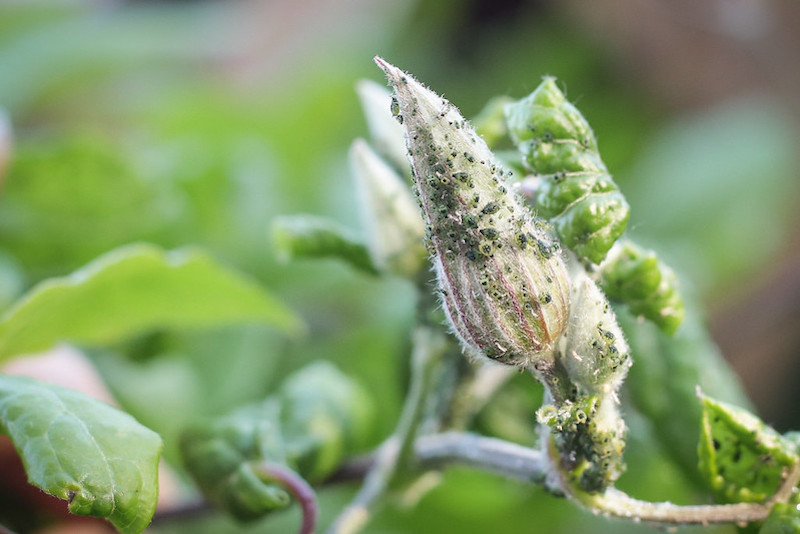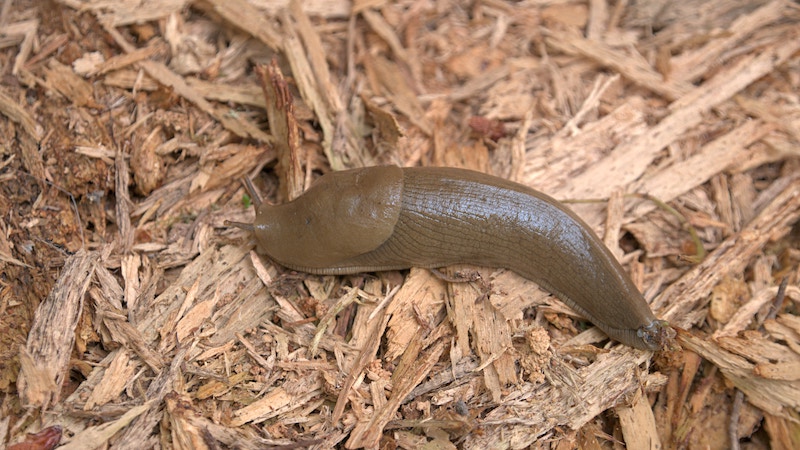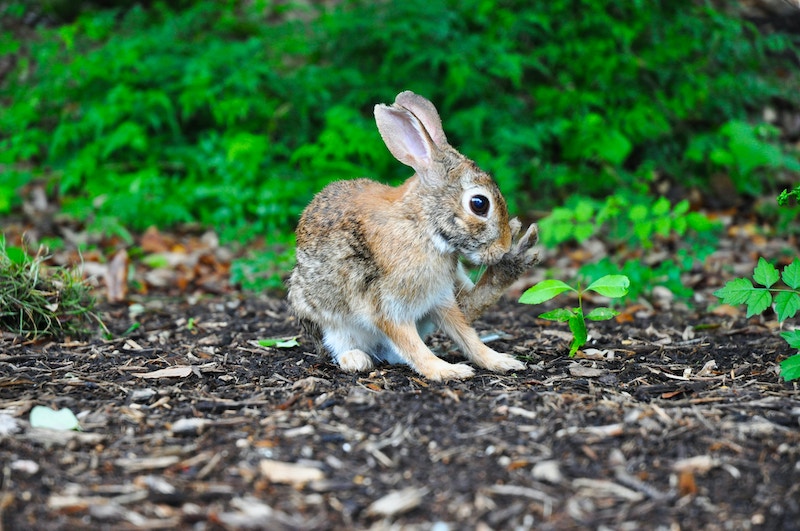Clematis is a diverse genus of flowering vines or shrubs that are commonly grown in home gardens. Hardy to USDA zones 3-9, these easy-to-grow plants are occasionally damaged by pests. The most common pests of clematis are aphids, scale, slugs, and rabbits. In most cases, the damage from these pests is only an aesthetic concern. Clematis pests can be easily managed through a variety of mechanical, cultural, and chemical controls.
Common Clematis Pests
Aphids
Aphids are common pests of clematis and other landscape plants in spring and summer. These tiny, soft-bodied insects are green, brown, or gray in color and are often seen in clusters on clematis vines. These pests are especially drawn to fresh growth, where they use their piercing-sucking mouthparts to sip fluids from the plant’s vascular system. Aphids can usually go unnoticed, as they are not a major health concern for clematis. Under severe infestations, stunted growth, wilting, and yellowed leaves may be present.

Unedited photo by Maja Dumat, Flickr, Copyright Creative Commons Licence BY 2.0
Aphids also excrete honeydew, a sugary substance that clings to the plant. Honeydew can encourage the growth of sooty mold, a grayish-black fungus that coats the honeydew. While neither honeydew nor sooty mold are harmful to the plant, they are unsightly and may attract other insects such as ants or wasps.
Treating Aphids on Clematis
Prune out any infested vines or branches. Use a hose on a high pressure setting to spray aphids off of the plant. While chemical control is rarely necessary, it may be warranted if your clematis is young or if aphid populations are high. Use neem or other horticultural oils to get rid of these pests. Apply it to all surfaces of the plant, making sure that it makes direct contact with the aphids. When used correctly, these chemical controls are not toxic to non-target insects.
Preventing Aphids on Clematis
Aphids have many natural predators, such as parasitoid wasps, lacewings, and ladybugs. Encourage natural predators to visit your yard by planting a diverse selection of trees, shrubs, and herbaceous plants, particularly those that are native to your region. Avoid using pesticides that can harm beneficial insects.
Scale
Scale insects are pests of clematis that are closely related to aphids. These pests are stationary for most of their life, attaching themselves to the stems of plants to feed on the sap. Once attached, they resemble small lumps on the stems and vines of clematis throughout the growing season. Scale insects will often coat themselves in a white, waxy substance. Damage from scale insects is rarely significant. Discolored and distorted growth is common, in addition to the production and growth of honeydew and sooty mold.
Treating Scale on Clematis
Heavily infested branches can be pruned. For smaller populations, a small brush can be used to scrape the pests off of the plant. Chemical controls are most effective during the crawler stage of this insect’s life cycle. Crawlers are the mobile scale nymphs, active in spring and summer. Apply horticultural oils to the plant thoroughly, making additional applications as needed. Apply dormant oils in early spring to kill any overwintering scale insects.
Preventing Scale on Clematis
Monitor your clematis plants for scale often. Remove the pests before infestations become significant. Like aphids, scale insects have many natural predators. Provide plenty of habitat and food sources for beneficial insects and birds by growing various species of flowering plants.
Slugs
Slugs are common pests of clematis and other plants. Feeding damage on clematis looks like irregularly-shaped holes in the leaves or flowers. In severe cases, leaves will have a lace-like appearance as slugs feed on the tissue between the veins. Most of the time, the damage is only cosmetic and does not have much effect on the health of the plant. When slug pressure is particularly high, more severe defoliation and stunted growth may occur, especially on younger, smaller plants.

Slugs overwinter in leaf debris, mulch, or soil. Eggs hatch in the spring once temperatures have warmed. Slugs will then remain active throughout summer and fall. These pests thrive in cool, shady conditions. They are mostly active at night but may also be visible during the day in shady areas or following rainfall.
Treating Slugs on Clematis
Pinch off any leaves that are severely damaged. Slugs can be hand picked off of plants and the surrounding soil. Check for slugs underneath or on your clematis, especially in the evening as they start to become active. Pick them up and dump them in a container of soapy water. There are several slug baits that are commercially available. These baits work by shutting down the digestive system of slugs, resulting in their death many days after consuming the bait. Select baits with active ingredients that are safe for people, pets, and wildlife, such as iron phosphate.
Preventing Slugs on Clematis
Remove weeds and other low-growing plants around your clematis, as these can provide a cool, shady habitat for these pests. Transplant your clematis to a sunnier location where slugs are less likely to feed on it. Consider using slug barriers if the slug population is high. Wide copper strips are an effective slug deterrent. They work by reacting with the mucus on the slug’s body, giving them an unpleasant shock sensation. Sprinkling diatomaceous earth around and on your plants may also work, but it needs to be reapplied often.
Rabbits
Rabbits are frequent browsers of clematis, particularly young plants. These animals will feed on clematis at any time of the year. Damage from rabbits will be evident as neat, clean-cut removal of stems, leaves, shoots, and flowers. For woody and evergreen clematis, rabbits can consume the bark and leaves during winter. Rabbit damage may be worse in some years than others due to fluctuations in the rabbit population and availability of other food sources.

Treating Rabbit Damage
Most clematis plants will recover from rabbit damage. Water your clematis well, especially during dry periods. Fertilize your clematis in early spring with a low-nitrogen fertilizer. Reapply fertilizer every 4-6 weeks throughout the growing season. Always water well after applying fertilizer. Reduce other sources of stress to the plant by pruning any dead, damaged, or pest-ridden vines.
Preventing Rabbits on Clematis
Remove any brush, debris, or overgrown weeds that can act as shelter for rabbits. Wrap wire cages around young clematis plants. Chicken wire or hardware cloth fastened around stakes will also work as a barrier against rabbits. Choose an organic deterrent spray to keep rabbits out of your garden. Just keep in mind that the spray will have to be reapplied after rain, and the rabbits may become accustomed to the smell after continuous use.
Clematis Pests Chart
|
Pest |
Identifying |
Treating |
|
Aphids |
Tiny, soft-bodied insects are green, brown, or gray in color |
Prune out any infested vines or branches and spray with high pressure water |
|
Scale |
Small lumps on the stems and vines, coated with white, waxy substance |
Apply horticultural oils to the plant thoroughly |
|
Slug |
Soft-bodied, elongated mollusks without shells |
Pick them up and dump them in a container of soapy water |
|
Rabbits |
Neat, clean-cut removal of stems, leaves, shoots, and flowers |
Water during dry periods and fertilize with a low-nitrogen fertilizer |
Sources: "Pests and Diseases." British Clematis Society. britishclematis.org
 |
Lauren Youngcourt - Published 05-11-2023 |
